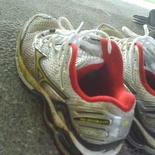With alot more people being ore active these days and considering that most Asians, particularly Singaporeans have a high percentage of people with IBS (irritable bowel syndrome), this bowel related problem might be of particular interest.
Ever went for a long run only to find lots of flatulence thereafter? Or worse, a strong urge to visit the toilet quite occasionally? This is largely due to the forces of running- Take an analogy of a sieve with sand & water, after continued shaking (running) the water and fine sand will be separated & filtered from the coarser sand, this is similar to the trapped gas & the bowels in your intestines, therefore the strong urge to pass lots of flatulence or increased bowel movements. This problem is actually quite common in long distance runners & is called the Runner’s Trots.
It’s a fact that running is good for maintaining regular bowel movements. This is one theory on why there is a decreased incidence of colon cancer among those who partake in running. BUT, it can also be said that it may be too much of a good thing.
Runner’s Trots is actually quite common: An estimated 20-50% of distance runners have “runner’s trots” with a range of symptoms from cramping and nausea to bouts of flatulence and diarrhea. This can occur during or after their exercise.
Why: The reasons are not known for sure, and may be due to factors affecting people differently. One reason considered, is that the up and down motion of running stirs the bowels. The flow of blood to the intestines is diverted to your legs and which may ‘trigger’ the cramping and/or diarrhea. The underlying possibility of irritable bowel disease may be brought to light by the additional stress of the exercise. The added chance of dehydration on long training runs may also cause diarrhea. Lactose intolerance effects enhanced by the exercise.
Symptoms: Cramping, nausea, flatulence, diarrhea during or after exercise. This may produce painful cramping and the compulsory need to defecate.
- Try to avoid eating for at least two hours before you exercise – the presence of food in the stomach will make things worse or contribute to the problem.
- Try to avoid the intake caffeine and warm fluids as it is possible for this to speed up the movement of wastes through the intestines.
- Make sure to limit your intake of dairy products, particularly if susceptible to diarrhea
- Limit high-fiber foods in the days before a long race.
- Avoid the foods that you know produce flatulence or loose stools.
- Drink plenty of fluids. It is best to drink a full 16 oz. of water an hour before your workout, giving the excess fluid time to pass through, and start off well-hydrated.
- Be aware of your bowel habits and try to time your workouts for after such movement times.
- If all other precautions fail, for races or special events where you know toilets will not be readily available, consider the use of an over-the-counter anti-diarrhea product such as Imodium. Studies have shown this has reduced problems related to those prone to exercise-induced diarrhea. It is not recommended to use this on a daily basis.
- Design your training routes to include a restroom. If you develop the urgency while exercsing, you will be able to plan your route accordingly.
- Consider a medical check-up for irritable bowel syndrome and be open in discussing your problem with your medical practioner.
Credit: Source
Preventing Runner’s Trots
Controlling runners trots

